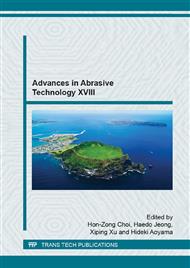[1]
I.D. Marinescu, M.P. Hitchiner, E. Uhlmann, W.B. Rowe, I. Inasaki, Handbook of Machining with Grinding Wheels, Taylor & Francis, (2006).
DOI: 10.1201/9781420017649
Google Scholar
[2]
Syoji K., Truing and dressing of superabrasive wheels, Machine and tools 2 (1989) 18–26.
Google Scholar
[3]
N. Ramesh Babu, V. Radhakrishnan, Murti, Y. V. G. S., Investigations on Laser Dressing of Grinding Wheels—Part I: Preliminary Study, J. Eng. for Industry 111 (1989) 244.
DOI: 10.1115/1.3188756
Google Scholar
[4]
N. Ramesh Babu, V. Radhakrishnan, Investigations on Laser Dressing of Grinding Wheels—Part II: Grinding Performance of a Laser Dressed Aluminum Oxide Wheel, J. Eng. for Industry 111 (1989) 253.
DOI: 10.1115/1.3188757
Google Scholar
[5]
N.B. Dahotre, S.P. Harimkar, Laser fabrication and machining of materials, Springer Science+Business Media, New York, N.Y., ©(2008).
Google Scholar
[6]
M. Rabiey, C. Dold, R. Transchel, K. Wegener, Influence of Picosecond Laser Touch Dressing of Electroplated Diamond Wheels on the Dressing of SiC Vitrified Bond Wheel, AMR 325 (2011) 189–194.
DOI: 10.4028/www.scientific.net/amr.325.189
Google Scholar
[7]
C. Zhang, Y. Shin, A novel laser-assisted truing and dressing technique for vitrified CBN wheels, International Journal of Machine Tools and Manufacture 42 (2002) 825–835.
DOI: 10.1016/s0890-6955(02)00014-7
Google Scholar
[8]
Y. Tian, Y.C. Shin, Thermal modelling and experimental evaluation of laser-assisted dressing of superabrasive grinding wheels, Proceedings of the Institution of Mechanical Engineers, Part B: Journal of Engineering Manufacture 221 (2007) 605–616.
DOI: 10.1243/09544054jem713
Google Scholar
[9]
H.W. Hoffmeister, J. Timmer, Laser Conditioning of Superabrasive Grinding Wheels, Industrial Diamond Review 60 (2000) 209–218.
Google Scholar
[10]
K. Wegener, H. -W. Hoffmeister, B. Karpuschewski, F. Kuster, W. -C. Hahmann, M. Rabiey, Conditioning and monitoring of grinding wheels, CIRP Annals - Manufacturing Technology 60 (2011) 757–777.
DOI: 10.1016/j.cirp.2011.05.003
Google Scholar
[11]
X. -Z. Xie, G. -Y. Chen, L. -J. Li, Dressing of resin-bonded superabrasive grinding wheels by means of acousto-optic Q-switched pulsed Nd: YAG laser, Optics & Laser Technology 36 (2004) 409–419.
DOI: 10.1016/j.optlastec.2003.11.002
Google Scholar
[12]
A. Hosokawa, T. Ueda, T. Yunoki, Laser Dressing of Metal Bonded Diamond Wheel, CIRP Annals - Manufacturing Technology 55 (2006) 329–332.
DOI: 10.1016/s0007-8506(07)60428-4
Google Scholar
[13]
A. Zahedi, T. Tawakoli, B. Azarhoushang, J. Akbari, Picosecond laser treatment of metal-bonded CBN and diamond superabrasive surfaces, Int J Adv Manuf Technol (2014) 1-13.
DOI: 10.1007/s00170-014-6383-5
Google Scholar
[14]
A. Zahedi, T. Tawakoli, J. Akbari, B. Azarhoushang, Conditioning of Vitrified Bond CBN Grinding Wheels Using a Picosecond Laser, Advanced Materials Research Advances in Abrasive Technology XVII (2014) 573–578.
DOI: 10.4028/www.scientific.net/amr.1017.573
Google Scholar
[15]
S. Malkin, C. Guo, Grinding Technology: Theory and Application of Machining with Abrasives, Industrial Press, (2008).
Google Scholar
[16]
A. Zahedi, T. Tawakoli, J. Akbari, Energy aspects and workpiece surface characteristics in ultrasonic-assisted cylindrical grinding of alumina–zirconia ceramics, International Journal of Machine Tools and Manufacture 90 (2015) 16–28.
DOI: 10.1016/j.ijmachtools.2014.12.002
Google Scholar


